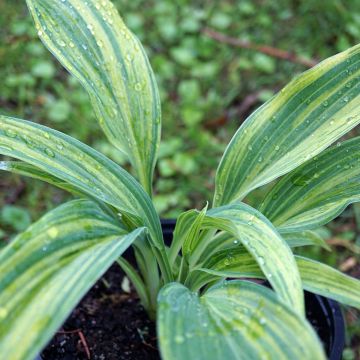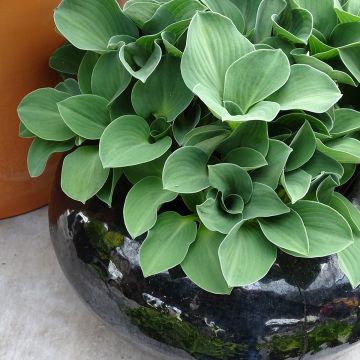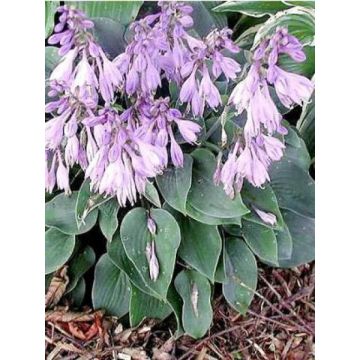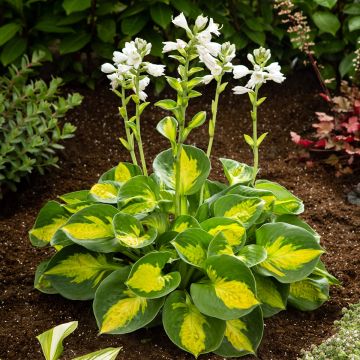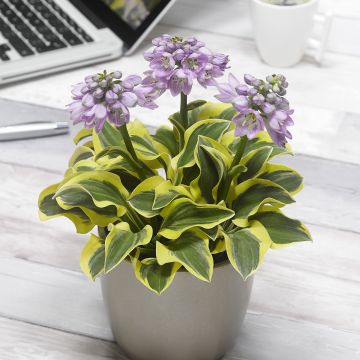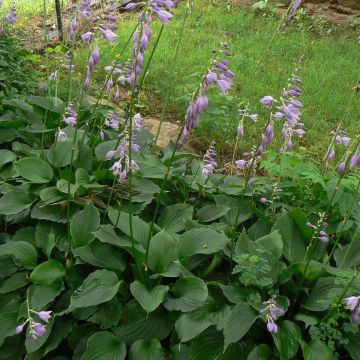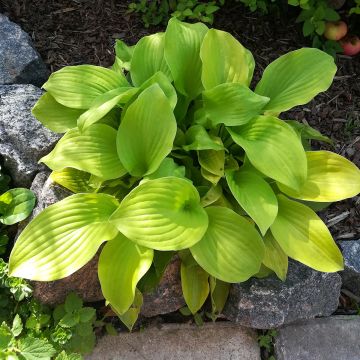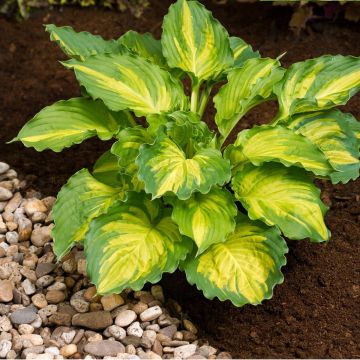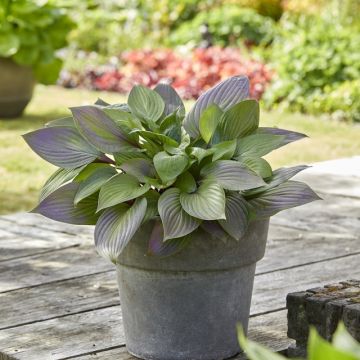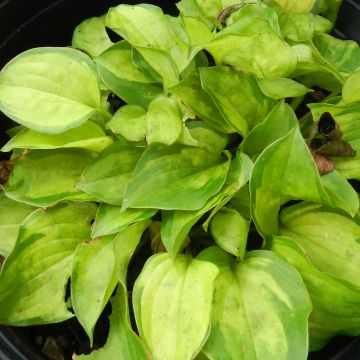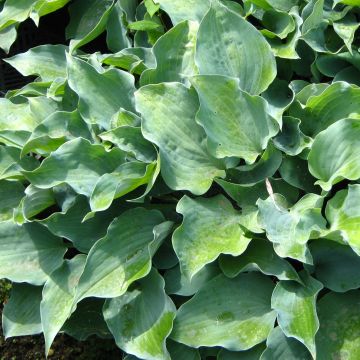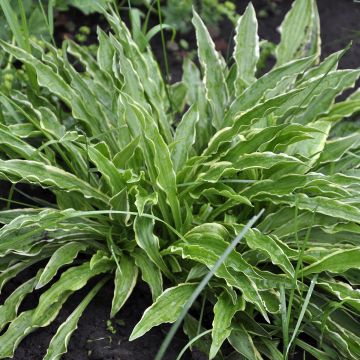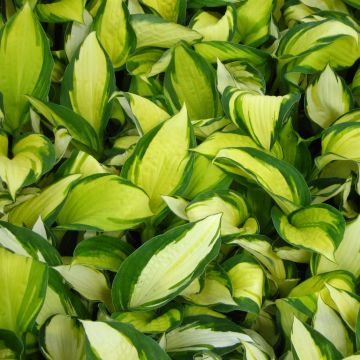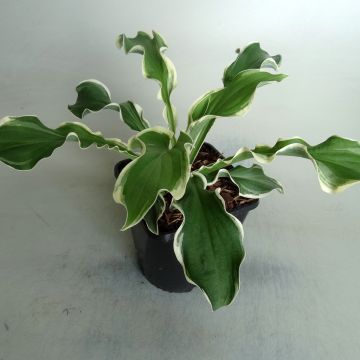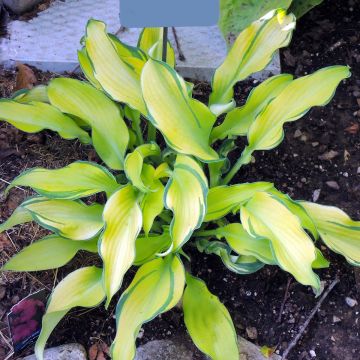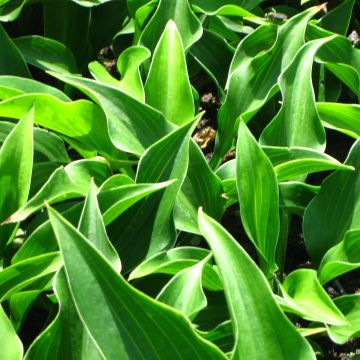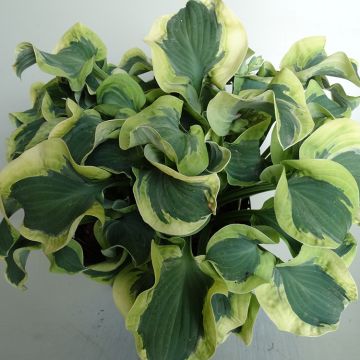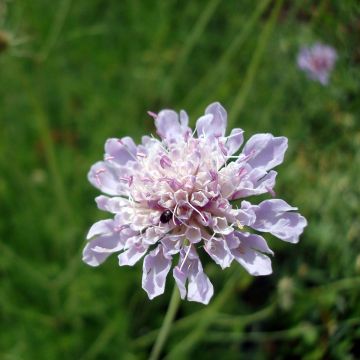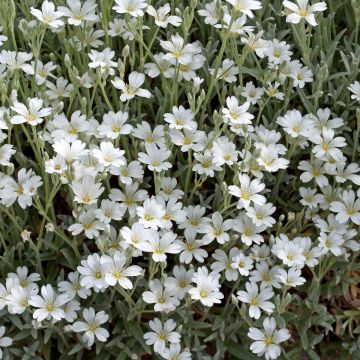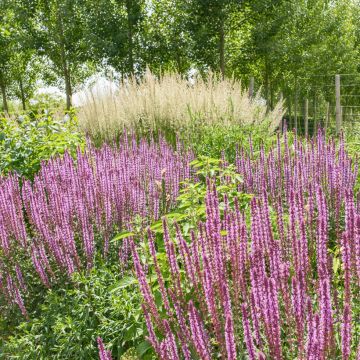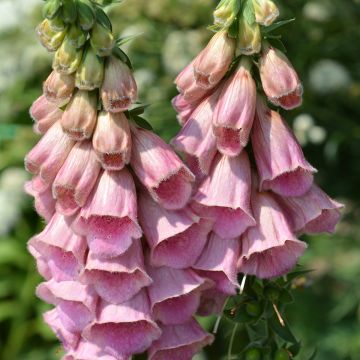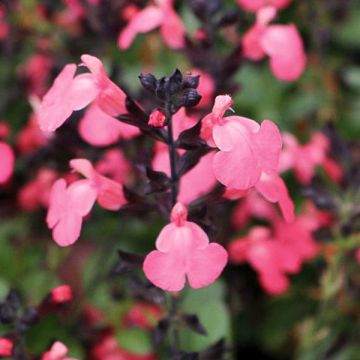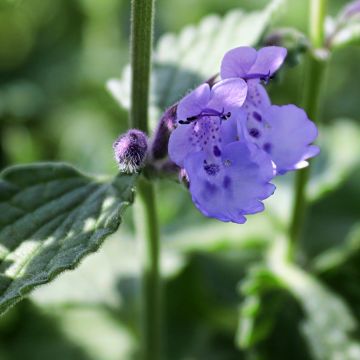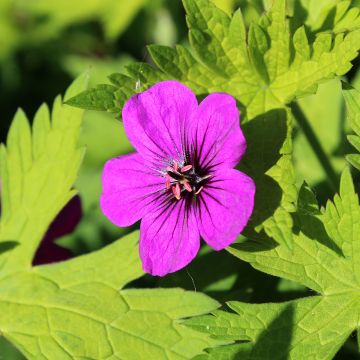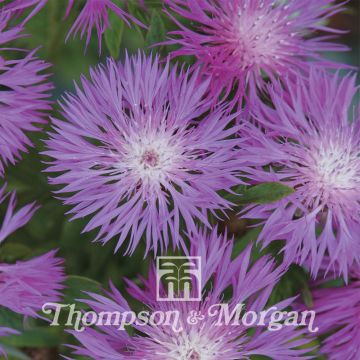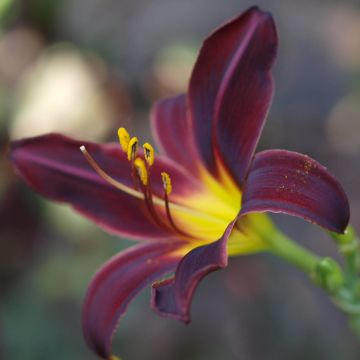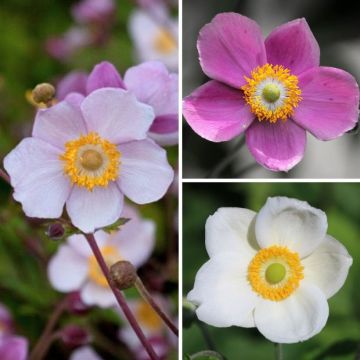

Hosta sieboldiana Herifu
Hosta sieboldiana Herifu
Hosta x sieboldiana Herifu
Plantain Lily, Funkia
Why not try an alternative variety in stock?
View all →This plant carries a 12 months recovery warranty
More information
We guarantee the quality of our plants for a full growing cycle, and will replace at our expense any plant that fails to recover under normal climatic and planting conditions.
From €5.90 for pickup delivery and €6.90 for home delivery
Express home delivery from €8.90.
Does this plant fit my garden?
Set up your Plantfit profile →
Description
Hosta 'Herifu', as delicate as a Japanese miniature, forms a cluster of small oval and elongated leaves in a delicious apple green shade, finely margined with cream. This almost dwarf variety, a hybrid of Hosta sieboldiana, shows quite rapid growth. Its summer flowering blooms in spikes of small lavender-purple flowers. It is an easy perennial to grow and succeed in damp soil. 'Herifu' is perfect in partial shade, in the company of perennials or even shrubs.
This Hosta is a completely hardy perennial, with a low and dense growth habit from spring onwards. It belongs to the asparagus family. The plant will reach a height of 25 to 30 cm (10 to 12in) and 40 cm (16in) in flower, spreading at least 40 cm (16in) quite rapidly. It forms a clump wider than it is tall. It is a long-lived plant with small deciduous leaves ending in a pointed tip, with visible veins. The leaves are uniformly bright green, outlined with a very fine cream edging. The flowering takes place in July-August, in the form of small pendant bells that can reach a height of 40 cm (16in).
The hybrid Hosta 'Herifu' will associate well in partial shade with numerous perennials such as astilbes, ferns, epimediums, and Claytonia sibirica, with which it forms beautiful colourful duos that require little maintenance. It will also look great in the company of columbines and tall foxgloves or small violets. It can also be paired with partial shade shrubs such as Mexican orange bushes, variegated hollies, and azaleas. All hostas grow well in pots and can remain in the same container for several years. Choose a special geranium potting compost to use during the growing season. As long as the foliage is not too dense, you can water from the top of the pot, keeping the soil moist throughout summer.
The majority of species spread in Western gardens have been introduced from Japan. Hostas are edible and are called urui in Japan, where they are commonly consumed.
Report an error about the product description
Hosta sieboldiana Herifu in pictures
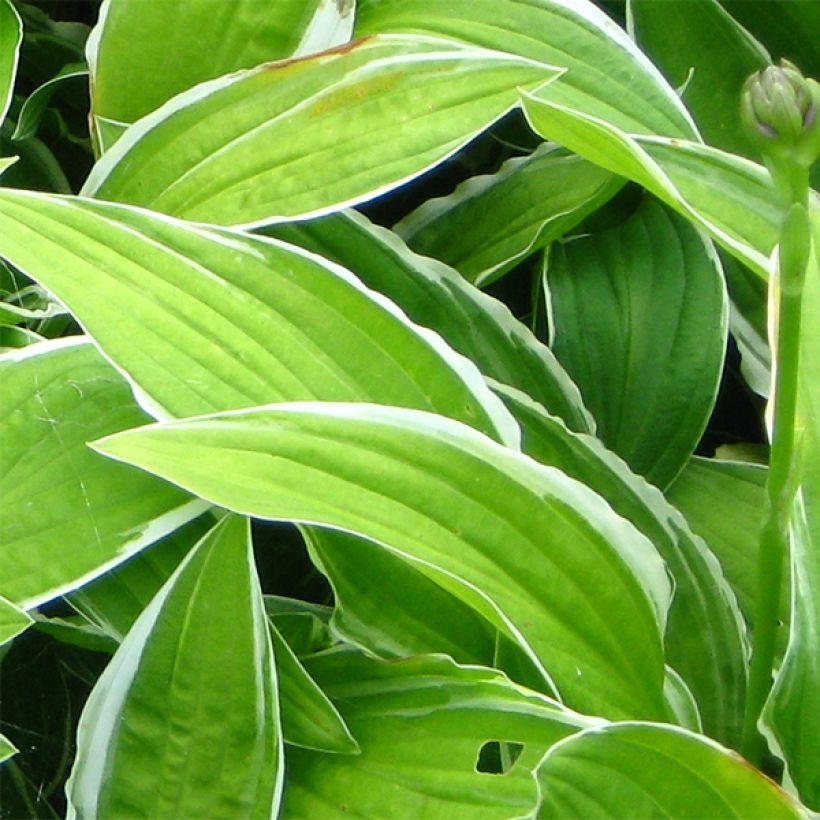

Flowering
Foliage
Plant habit
Botanical data
Hosta
x sieboldiana
Herifu
Liliaceae - Hostaceae
Plantain Lily, Funkia
Cultivar or hybrid
Other Dwarf Hostas
Planting and care
Hostas are planted in spring or autumn. Hostas thrive in deep, humus-rich, loose soil, which is preferably neutral to acidic and moist to wet throughout the year. Plant them in partial shade or dappled shade, and in a sheltered location away from strong winds.
Prepare a planting hole that is 20 cm (8in) x 20 cm (8in) x 20 cm (8in). If your soil is heavy, mix equal parts of compost with the prepared soil, partially backfill the hole, and place your plant in such a way that the top of the root ball is covered with 3 cm (1in) of soil. Adding a fertiliser e.g. bonemeal will nourish your plant during its rooting period. Make sure to position the neck of the plant well above ground level. Firmly tamp the soil and water generously to eliminate air pockets. If the weather is dry, regular watering for a few weeks will help your plant to establish. Water regularly in case of a dry summer.
With their preference for moist habitats, slugs and snails are never far away from hostas. Even though blue or variegated hostas often have thicker and tougher foliage, making them less appetising for slugs, these plants need protection from gastropods. Safeguard your hosta plants by surrounding them with ferramol-based slug pellets (approved in Organic Agriculture), eggshells, coffee grounds, wood chips, or any dry and rough natural substance that repels them. Hedgehogs are the gardeners' best allies in the fight against gastropods, as unlike chickens, they do not till the soil and do not attack the young green shoots of plants. Or you can use plants have a repulsive odour to slugs, such as wormwood and garlic.
Planting period
Intended location
Care
-
, onOrder confirmed
Reply from on Promesse de fleurs
Summer flowering perennials
Haven't found what you were looking for?
Hardiness is the lowest winter temperature a plant can endure without suffering serious damage or even dying. However, hardiness is affected by location (a sheltered area, such as a patio), protection (winter cover) and soil type (hardiness is improved by well-drained soil).

Photo Sharing Terms & Conditions
In order to encourage gardeners to interact and share their experiences, Promesse de fleurs offers various media enabling content to be uploaded onto its Site - in particular via the ‘Photo sharing’ module.
The User agrees to refrain from:
- Posting any content that is illegal, prejudicial, insulting, racist, inciteful to hatred, revisionist, contrary to public decency, that infringes on privacy or on the privacy rights of third parties, in particular the publicity rights of persons and goods, intellectual property rights, or the right to privacy.
- Submitting content on behalf of a third party;
- Impersonate the identity of a third party and/or publish any personal information about a third party;
In general, the User undertakes to refrain from any unethical behaviour.
All Content (in particular text, comments, files, images, photos, videos, creative works, etc.), which may be subject to property or intellectual property rights, image or other private rights, shall remain the property of the User, subject to the limited rights granted by the terms of the licence granted by Promesse de fleurs as stated below. Users are at liberty to publish or not to publish such Content on the Site, notably via the ‘Photo Sharing’ facility, and accept that this Content shall be made public and freely accessible, notably on the Internet.
Users further acknowledge, undertake to have ,and guarantee that they hold all necessary rights and permissions to publish such material on the Site, in particular with regard to the legislation in force pertaining to any privacy, property, intellectual property, image, or contractual rights, or rights of any other nature. By publishing such Content on the Site, Users acknowledge accepting full liability as publishers of the Content within the meaning of the law, and grant Promesse de fleurs, free of charge, an inclusive, worldwide licence for the said Content for the entire duration of its publication, including all reproduction, representation, up/downloading, displaying, performing, transmission, and storage rights.
Users also grant permission for their name to be linked to the Content and accept that this link may not always be made available.
By engaging in posting material, Users consent to their Content becoming automatically accessible on the Internet, in particular on other sites and/or blogs and/or web pages of the Promesse de fleurs site, including in particular social pages and the Promesse de fleurs catalogue.
Users may secure the removal of entrusted content free of charge by issuing a simple request via our contact form.
The flowering period indicated on our website applies to countries and regions located in USDA zone 8 (France, the United Kingdom, Ireland, the Netherlands, etc.)
It will vary according to where you live:
- In zones 9 to 10 (Italy, Spain, Greece, etc.), flowering will occur about 2 to 4 weeks earlier.
- In zones 6 to 7 (Germany, Poland, Slovenia, and lower mountainous regions), flowering will be delayed by 2 to 3 weeks.
- In zone 5 (Central Europe, Scandinavia), blooming will be delayed by 3 to 5 weeks.
In temperate climates, pruning of spring-flowering shrubs (forsythia, spireas, etc.) should be done just after flowering.
Pruning of summer-flowering shrubs (Indian Lilac, Perovskia, etc.) can be done in winter or spring.
In cold regions as well as with frost-sensitive plants, avoid pruning too early when severe frosts may still occur.
The planting period indicated on our website applies to countries and regions located in USDA zone 8 (France, United Kingdom, Ireland, Netherlands).
It will vary according to where you live:
- In Mediterranean zones (Marseille, Madrid, Milan, etc.), autumn and winter are the best planting periods.
- In continental zones (Strasbourg, Munich, Vienna, etc.), delay planting by 2 to 3 weeks in spring and bring it forward by 2 to 4 weeks in autumn.
- In mountainous regions (the Alps, Pyrenees, Carpathians, etc.), it is best to plant in late spring (May-June) or late summer (August-September).
The harvesting period indicated on our website applies to countries and regions in USDA zone 8 (France, England, Ireland, the Netherlands).
In colder areas (Scandinavia, Poland, Austria...) fruit and vegetable harvests are likely to be delayed by 3-4 weeks.
In warmer areas (Italy, Spain, Greece, etc.), harvesting will probably take place earlier, depending on weather conditions.
The sowing periods indicated on our website apply to countries and regions within USDA Zone 8 (France, UK, Ireland, Netherlands).
In colder areas (Scandinavia, Poland, Austria...), delay any outdoor sowing by 3-4 weeks, or sow under glass.
In warmer climes (Italy, Spain, Greece, etc.), bring outdoor sowing forward by a few weeks.

































